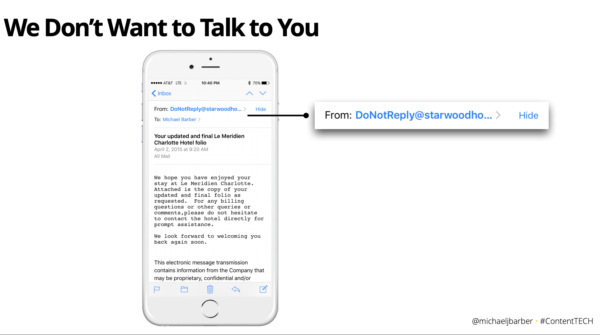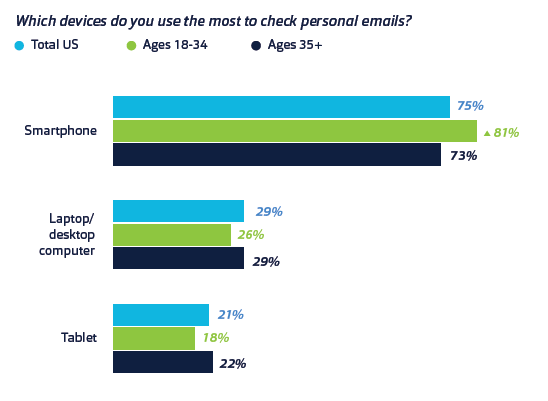 Tom Hanks has been everywhere recently talking about his role as beloved TV icon Mr. Rogers in the film A Beautiful Day in the Neighborhood. But as I look over CMI’s 2019 posts, a different Tom Hanks movie (this one from over 20 years ago) comes to mind: You’ve Got Mail.
Tom Hanks has been everywhere recently talking about his role as beloved TV icon Mr. Rogers in the film A Beautiful Day in the Neighborhood. But as I look over CMI’s 2019 posts, a different Tom Hanks movie (this one from over 20 years ago) comes to mind: You’ve Got Mail.
It seems quaint to recall the days when a voice-delivered email notification generated so much excitement and anticipation that someone hung a whole movie on it. Today, notifications get routinely ignored, funneled into spam folders or, worse, prompt feelings of existential ennui or overload.
And yet, we just can’t quit email. Everybody uses it. Marketers and consumers. Boomers and Gen Z. Politicians. Teachers. Students. Job seekers. Employees. You get it, the list goes on.
We use email because we must. And because it works.
We use #email because we must. And because it works, says @KMoutsos via @cmicontent Click To TweetIt is still possible to create email messages that surprise and delight, it’s just harder. But to have successful relationships with your email subscribers, you’ve got to deliver that feeling regularly.
To help you breathe new, surprising, and delightful life into your email strategy, I gathered these reminders from helpful articles and presentations from 2019.
Segment that list
Long before you spill any more digital ink, take a good, long look at your list. Aside from the fact that the people on this list willingly handed over their email addresses, what do they have in common?
One approach to segmentation is to sort your list into groups according to where they are in their customer lifecycle. Kevin George details the lifecycle email approach in depth – here’s a snapshot of the segments:
- New subscribers
- New customers
- Active subscribers/customers
- Dormant subscribers/customers
- Reengaged subscribers/customers
Needs and expectations vary among the groups (and additional segments you might create based on, say, demographics). Tailoring content to the unique needs of each should give your open rates and engagement a lift. It can even help reconnect dormant subscribers (or at least clean up your list) as this reengagement example shows:

Segmenting is far from a new practice. But if you’re not doing it or not tailoring your email content to match the needs of the segment, you’re missing opportunities to make your content relevant.
Worse, you risk wasting your audience’s time. Andrew Davis offers this (unsolicited) advice about email newsletters that aren’t relevant:
“If it’s wasting your audience’s time, it’s probably not delivering results. If it’s not producing results, maybe you shouldn’t be sending it. Which means you have two options: strike it or fix it.”
HANDPICKED RELATED CONTENT:
Work to get the open
When rethinking your email newsletter or email campaign, it’s tempting to dive into the copy. But people won’t see your amazing, relevant content if you don’t first get them to click on the email.
Michael Barber suggests focusing on the very elements people see first: the “From” name that identifies the sender, the subject line, and visual cues.
From name
The From name element should involve more care than simply using the name of the brand. In his funny and eye-opening talk at ContentTECH Summit (and CCO interview), Michael shares how marketers get that From name email address wrong.
Consider the impression the From name can create:

Pretty sure “do not reply” isn’t the goal of anyone’s email strategy.
The From name is important enough that it also shows up as one of the 7 Easy Ways to Super Boost Your Newsletter Open Rate Michael Brenner offered earlier this year.
Michael suggests that using your brand name in the From field works for B2C brands with great name recognition (like Coca-Cola or Banana Republic). For B2B companies or B2C brands that are less well known, associating the email with a community manager or company leader will help readers feel more of a connection with the sender and your company.

And, Michael reminds us, once you settle on a sender name, don’t forget to set the e-newsletter’s reply email to match the name in the From line.
Subject line
If you’re hampered by a maximum length when attempting great subject lines, set your creativity free.
The length of the subject line doesn’t matter. (Michael Barber cites research from Phrasee to back this up). What does matter?
- Sentiment – As Michael put it, “… words matter. The emotions we convey in the subject lines are more impactful than the length of that subject line.”
- Diversity – Or, Michael says, “different strokes for different folks.” It’s one reason why segmenting matters. You’ve got to know who you’re talking to, and how they communicate. He offers this example of how differently people express surprise:
- Michael’s British mum: “I’m surprised by that”
- Michael’s 14-year-old neighbor: “I’m shooketh.”
- Sophistication – This isn’t about length, Michael says, it’s about getting the message across: “Simpler is better.”
Emojis and visual cues
Don’t forget that the inbox is visual. What better way to stand out in a sea of text than by including a few images? Emojis are one approach (to know whether they work for your audience, you’ll need to test – more on testing later).
Michael Barber points to an emerging standard called Brand Indicators for Message Identification (BIMI), which includes the ability to add a brand icon or other image next to the From name.
Design for a mobile world
When I wrote no one will see your incredible content if they don’t open the email, I imagined a chorus of cries, “What about the preview pane?” Sure, some desktop email services offer a preview pane.
But if you rely on a preview pane to get around weak subject lines or to avoid testing sender names, you’re leaving potential opens on the table. More people read email on smartphones than on desktops, according to a gated study from Fluent. As Michael Brenner notes, “If you don’t optimize your email for smartphones it might already be on its way to oblivion.”

Michael Barber offered these suggestions for mobile optimization:
Single column layout
Social media apps like Instagram, Facebook, and Twitter have trained smartphone users for the scroll. A “skinny” email layout lets readers mimic that action.

Headlines, body copy, and buttons
Reading (and clicking/tapping) on a phone is different, so design with phones in mind. If people must pinch and zoom to read or tap, they won’t do it. Set and stick to minimum sizes for these email elements:
- Headlines at least 30 pixels
- Body copy at least 16 pixels
- Buttons at least 44 by 44 pixels (placed above the “scroll” doesn’t hurt either)

Slim headers
Resist the temptation to clutter the top of your email with too many elements. The goal should be to get the reader to your content as quickly as possible.
Aim for this:

Not this:

Test after you segment
When it comes to email testing, you may feel like you’ve got it covered. You know how to test subject lines, sender names, images, color, copy, and pretty much any element.
But are you testing them correctly? Michael Barber cautions against simply choosing random slices of your audience for A/B tests. If you just grab, say, 10% of your audience for testing, that group might include different kinds of readers (e.g., active engagers, dormant readers, new subscribers, and long-term customers).
“If we’re making decisions based on an A/B test of our entire database and then applying the result on someone that’s been in our database for 10 years vs. someone who’s been in for a couple of hours, that could have detrimental effects on email performance,” Michael says.
Don’t fear the unsubscribe, but do offer options
No one sends email hoping people will unsubscribe. But Kevin George suggests that unsubscribes aren’t always a bad thing.
When people who aren’t interested in your content unsubscribe, your sender reputation quality is maintained, which is important for future deliverability. It also improves the quality of your list. These unsubscribers didn’t report you as spam, they simply indicated they no longer want to receive your content. If you ask for feedback – and learn from it – unsubscribes can help you improve your email content.
Don’t assume, though, that unsubscribing is an all-or-nothing proposition. If you send more than one type of email, let people choose what they want to continue receiving. Kevin shares an example from Travelocity:

Your unsubscribe page or preference center also can offer a frequency choice (e.g., from daily to weekly or weekly to monthly) rather than an unsubscribe-only option.
Treat people like, well, people you like
Earlier this year, we asked some of the smartest people we know – Content Marketing World 2019 speakers – what email mistakes they routinely see.
A recurring theme? Not caring about readers. Really. You work so hard to get people to give their email addresses and then they feel like you really don’t care.
One of the worst examples came from Sarah Mitchell who described her attempts (yes, plural) to get a company to stop sending her annual reminders to purchase a gift for her father after he died.
Other email mistakes that say you don’t care about the reader as a person include:
- Sending pitches more frequently than useful information
- Making assumptions about a person based on the name or demographic
- Resending emails that hadn’t earned an open the first time
- Not offering a choice of delivery frequency
The impact of these missteps is huge. Michael Barber puts it this way: “Every time we deliver a message to the inbox – whether it’s transactional, promotional, or a newsletter – and we’re not as timely, targeted, and relevant as possible, we’re slowly erasing the relationship [we’ve built].”
Sure, our feelings about email have changed since Tom Hanks and Meg Ryan met cute via AOL in 1998. But that doesn’t mean the spark is gone. What will you do to rekindle your email relationships in 2020?
CMI takes its email relationship seriously. When you subscribe to the free weekday newsletter, you can trust you’ll get helpful tips, original research, and inspiring examples. Join us today.
Cover image by Joseph Kalinowski/Content Marketing Institute

